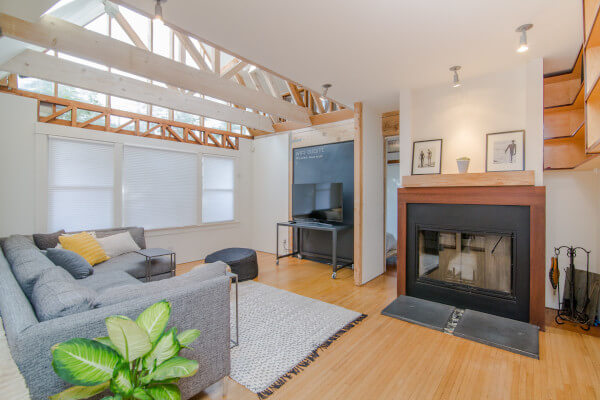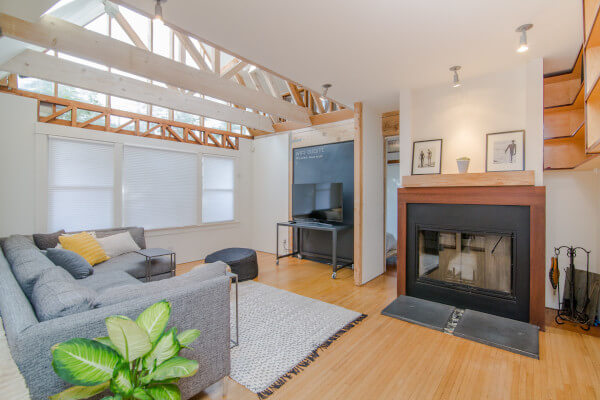The Best Firewood to Heat Your Home

>

iStock
Learn why one wood is better than another, the differences between hardwood and softwood, and safety tips for your woodburning appliance.
Burning wood is a great way to heat your home. A fire is warm and dry, and there’s nothing like the warmth of its glow on a cold evening. If you use a wood stove or wood-burning fireplace to heat your home, you may wonder which types of wood are the best to burn. Here, we’ll look at a few kinds of wood, their benefits and drawbacks, and which to use in your fire.
Hardwood vs. Softwood
Wood is classified as either hardwood or softwood. Hardwood comes from deciduous trees (those that drop their leaves in the fall), and softwood comes from evergreens like pine and spruce. The sap in softwoods creates an instant hot fire, but overuse causes creosote buildup in your chimney.
Creosote is a sticky substance that adheres to the chimney or flue liner as the wood smoke rises. Comprised mainly of tar, creosote is highly flammable and is the primary cause of chimney fires. Because softwoods produce more creosote than hardwoods, they are best reserved for getting a fire going quickly. Hardwoods burn hotter and longer and are the preferred woods to use for a fire that lasts.
Top Woods to Burn for Heat
Heat is measured by British Thermal Units (BTUs). The BTU of wood varies by species. You may think it’s best to burn the hottest-rated woods, but they also tend to be the hardest to split. So, that’s something to keep in mind if you’re splitting your own firewood.
Here are a few of the most used firewoods and their BTU ratings in the millions per cord. A cord is 128 cubic feet of stacked firewood.
Osage orange—32.9Shagbark hickory—27.7Black locust—26.8Apple—26.5Red oak—24Black walnut—20.2Spruce—14.5White pine—14.3Savvy wood burners use a variety of woods in their stoves and fireplaces. They use softwoods to start a fire or to mix with midrange wood on a super-cold night. And they save the hardest woods for fires they want to last the longest.
Benefits of Heating with Wood
Burning wood saves on your electric bill and reduces the use of fossil fuels. If you own wooded acreage, the downed trees alone could heat your home for several years. And if you have to buy wood to burn, it’s typically less expensive than other heating sources.
Firewood Safety Tips
When burning wood for heat, safety begins in the woodlot. Always wear personal protective equipment when cutting wood. A helmet with a face shield, eye and ear protection, and chainsaw chaps are standard when operating a chainsaw. When splitting wood with an ax, always wear eye protection and steel-toed boots. Leather gloves also protect your hands from splinters and blisters.
Have your chimney cleaned of any creosote buildup in the house and inspected yearly for cracks or other damage. If you have a woodstove, read the owner’s manual, so you’re familiar with how to operate it. Avoid overheating a woodstove by adequately using the damper for airflow.
Never burn wood in a stove with the door open or use a fireplace without a protective screen. If you have to leave the house or go to bed, shut down a stove’s dampers and extinguish any fire in an open fireplace. Other important safety tips include:
Only burn seasoned wood, not green or wet wood, producing a potentially hazardous creosote buildup in the chimney.Keep wood, paper, furniture, and curtains away from the fireplace or stove.Only use kindling, newspaper, or all-natural fire starters. Never use petroleum products to start a fire.Store removed ashes in a covered metal container outside on a non-flammable surface.Check the labels on manufactured logs to see if they’re safe to use in a woodstove.Always have a fire extinguisher handy and check it each year when you have your chimney inspected.Never allow a child to operate a fireplace or woodstove.Nothing tops the glow, warmth, and crackle of a fire in the fireplace. And with the proper safety measures in place, your firewood selection should help keep your home comfortable all winter long.
Did you miss our previous article…
https://www.tampa-bay-homes-guide.com/?p=1749
